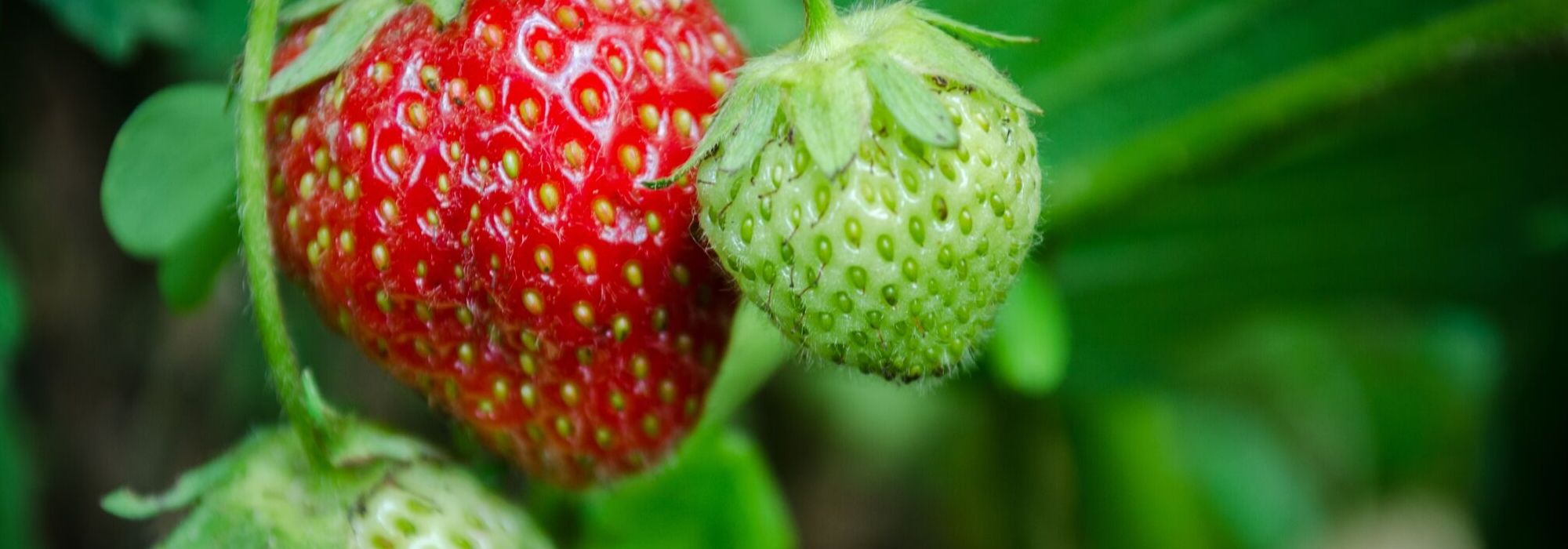
Strawberries: planting, growing and care
Contents
Strawberries, in a nutshell
- Strawberry plants are perennial plants producing much-appreciated red fruits. They are very hardy and have stolons that allow easy propagation and formation of good groundcover.
- Renewal of strawberry growing bed is recommended every three years to improve yield.
- Varieties bear large or small fruits, perpetual or not. Non-perpetual varieties provide a harvest of around three weeks between May and July, better suited to jam-making. Perpetual varieties produce from June until first frosts.
A word from our expert
Strawberry (Fragaria x ananassa) is one of the earliest fruits of the garden, it heralds arrival of summer with its fresh, highly fragrant fruit, an extraordinary glossy red, eaten raw with sugar or whipped cream, in salads, in tarts, dried or as sorbet or cooked to make coulis and jams. Strawberry plant is considered a vegetable-garden crop because strawberry young plants are more often found in vegetable gardens than in orchards, even though it belongs to same family as apple, pear and peach trees. It is placed in category « small fruits ».
Strawberry plants form attractive groundcovers with compound leaves of three dentate leaflets, often glossy of a lovely green but also hanging baskets both appetising and ornamental especially with varieties Mount Everest or Toscana which show pink flowers and excellent fruit. The herbaceous clump thickens slowly or spreads by forming stolons, very easy to transplant at end of summer to enlarge the plot.
Strawberry is an easy plant to grow in garden, in ground but also in large pot, on terrace or balcony. Production can be spread over several months thanks to warmth of greenhouse but also to multiple perpetual and non-perpetual varieties which allow harvest from May until frosts. Plant still needs cold to properly initiate flowering. This is why most strawberry crops are grown under glass in rockwool blocks to limit diseases caused by soil fungi, and are renewed every year. In garden, renewal of young plants is generally carried out every 3–4 years.
Did you know that scientific name of strawberry, Fragaria, comes from Latin « fragare » meaning « to perfume », whence derives word fragrance, a term describing an exaltation of sweet scents ? Species name ananassa comes from pineapple scent obtained by cross-breeding of two species, the Virginia strawberry (Fragaria virginiana), native to Canada, with a pronounced flavour and brought back by Jacques Cartier in 16th century, and the Chilean strawberry (Fragaria chiloensis) with large fruit and white flesh, which navigator Amédée François Frézier, a botany enthusiast, introduced to France in 1714 under reign of Louis XIV, about two centuries later !
Let’s not forget woodland strawberry (Fragaria vesca), common in our European understories except in Mediterranean, with a distinctive scent that still appeals to consumers and which is found, for example, in ‘Mara des bois’ strawberry. This type of strawberries forms clumps of 20–30 cm across, without stolons.
Description and botany
Botanical data
- Latin name Fragaria x ananassa
- Family Rosaceae
- Common name Strawberry
- Flowering May to October
- Height between 20 and 30 cm
- Exposure full sun or partial shade
- Soil type any loose soil, rich and well drained, slightly acidic.
- Hardiness Excellent (-28 °C)
Genus Fragaria comprises around fifteen species native to temperate zones of Northern Hemisphere except one that probably changed course of strawberry history. Without Chilean strawberry (Fragaria chiloensis), this small red fruit would likely have remained a marginal crop. Strawberry history is indeed the result of an astonishing series of chance events. Harvesting of wild strawberry (Fragaria vesca) began in Europe in prehistoric times. This species is also present in North and South America, North Africa and temperate Asia, and inhabits woods or hedge bases up to 1,600 m altitude, on rather dry, calcareous-leaning soils. From 14th century, it was cultivated for medicinal use of roots, leaves and fruit, with 12,000 plants planted in Louvre gardens in 1368.
Most of the strawberry plants grown today are hybrids resulting from cross-breeding of two species, Virginia strawberry (Canada) or scarlet strawberry (Fragaria virginiana) and Chilean strawberry (Fragaria chiloensis). The former, very flavoursome and hardier than European strawberries, was brought back by Jacques Cartier during his exploration of Canada under François I. It enjoyed great success and was cultivated in France around Brest and in England until late 19th century. The latter, Fragaria chiloensis, also produces fairly large fruit with white or red skin but white flesh. A few plants that survived voyage of Amédée François Frézier, a military engineer sent by Louis XIV to reconnoitre Spanish fortifications and passionate about botany, produced no fruit. They came from Chiloé Island, exposed to harsh conditions (2,000 mm rainfall, strong winds and mean annual temperature of 8.5°C). Normally hermaphrodite, the five plants brought back unfortunately lacked stamens, preventing fruiting. By chance both species were cultivated in same place, at Plougastel-Daoulas (Finistère), producing in 1760 an extraordinary hybrid named Fragaria x ananassa with large fruits whose scent recalls pineapple, ancestor of most modern strawberries. At same time, young Versailles botanist Antoine Nicolas Duchesne deliberately obtained crosses in 1761 between these two species, naming them “Fraisier de Versailles”.
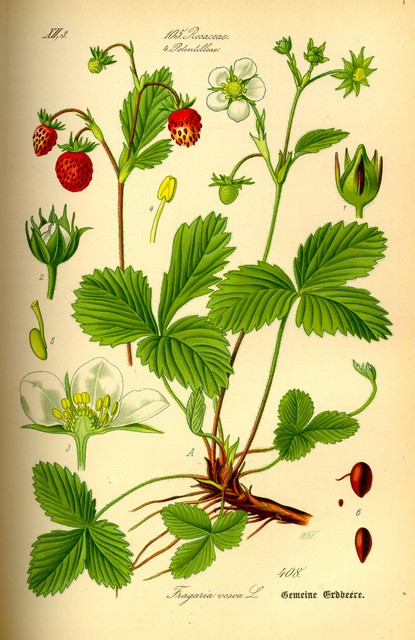
Fragaria vesca – botanical illustration
Strawberries are semi-evergreen perennials, creeping or forming compact tufts, slow-growing. Leaves arranged in a rosette partly die back at end of summer, often spotted by anthracnose and regrow without problem at first signs of warming. Leaves petiolate with a long thick petiole are compound with 3 (sometimes 5) ovate, crenate leaflets, 3–4 cm long, lamina strongly veined and more or less downy depending on species, glossy mid-green.
Flowers, arranged in alternate cymes at end of a long stem usually rising above foliage, are typical of family Rosaceae with five white or pink-tinged petals, rounded at edges, surrounding a yellow centre. Calyx doubled by the calyculus forms a collar with large teeth that persists at base of fruit. Floral receptacle bears a few ranks of stamens that surround numerous free carpels, each topped by a tiny pistil, origin of the small grains covering strawberry surface. Each carpel fertilised by a bee is an achene (carpel with a single ovule giving a dry fruit) which produces a plant hormone making floral receptacle grow fleshy. This aggregation of achenes is called a pseudocarp. Little grains dotted across strawberry correspond to achenes while flesh of fruit derives from receptacle which swells and thickens, taking a round, elongated or triangular shape. Most strawberries are red with shades ranging from orange-red as in Gariguette to deep red in Cherry Berry, but there are white-fruited forms such as Pineapple or some Chilean strawberry forms. As seen in strawberry history, some flowers or plants can be unisexual, requiring a partner to fruit. Note that even on hermaphrodite plants, presence of bees remains essential to ensure regular fruit development.
Strawberry, richer in vitamin C than orange, is among lowest-calorie fruits. 150 g is enough to cover daily needs. It boosts immune defences thanks to provitamin A content, and supports cell renewal thanks to vitamin B9, essential for pregnant women in particular. It also contains significant amounts of magnesium, calcium and iron. It can cause urticaria in sensitive people. Infusions or decoctions of leaves picked in spring and rootstocks harvested in winter from wild strawberry are diuretic and astringent. Famous botanist Carl von Linné treated his painful gout with this plant.
Read also
Planting bare root strawberriesMain strawberry varieties
Different strawberry varieties fall into several categories. In particular, one distinguishes:
- Non-perpetual strawberry plants, producing large fruits such as Gariguette, Ciflorette, which have a very abundant concentrated crop around June, lasting about three weeks; choose according to harvest timing (early, mid-season or late) to stagger harvest.
- Perpetual large-fruited strawberry plants such as Gento, Ostara, which have a spreading production from May until the frosts but in smaller quantities, often with a resting period in July–August.
- Wild strawberries or four-seasons strawberries such as Reine des Vallées, producing small, highly fragrant fruits continuously from June to October.
- Ornamental and gourmet varieties such as Mount Everest, which is grown in hanging baskets, or Toscana, which presents a pretty pink flowering. The Pink Panda strawberry, with bright pink flowers bearing six petals or more, results from a cross-breeding between a garden strawberry and a marsh potentilla. It rarely fruits.

Strawberry Gariguette - Fragaria ananassa
- Height at maturity 25 cm

Strawberry Ciflorette - Fragaria ananassa
- Height at maturity 25 cm

Strawberry Magnum Marionnet 97 - Fragaria ananassa
- Height at maturity 25 cm

Wild Strawberry Mara des Bois plants (everbearing)
- Height at maturity 25 cm

Strawberry Gento (everbearing) - Fragaria ananassa
- Flowering time June to October
- Height at maturity 25 cm

Strawberry Ostara (everbearing) - Fragaria ananassa
- Height at maturity 25 cm

Strawberry Toscana F1 Deep Rose plugs - Fragaria ananassa
- Flowering time June to October
- Height at maturity 10 cm

Climbing strawberry Mount Everest plants - Fragaria ananassa
- Flowering time June to August
- Height at maturity 1,25 m
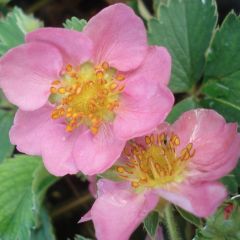
Fragaria Pink Panda
- Flowering time July to September
- Height at maturity 30 cm
Discover other Strawberry seeds
View all →Available in 1 sizes
Available in 1 sizes
Available in 1 sizes
Available in 1 sizes
Available in 1 sizes
Available in 1 sizes
Available in 1 sizes
Available in 1 sizes
Planting strawberries
Where to plant strawberries?
Strawberry is a very hardy perennial (-28°C), tolerant of montane climate like blueberry or raspberry. Hybrid varieties tolerate frosts of between -15 and -20°C. Plant even needs cold to induce flowering so increase in temperature in a greenhouse should not begin before February.
Strawberries prefer a good garden soil, deep, humus-bearing and workable, slightly acidic, which you enrich annually with compost, manure or other organic fertiliser. Choose a fairly sunny spot although strawberry also copes with partial shade. Strawberry plants make good companions for garlic, beans, lettuce, onions, leek, thyme and spinach. However, they do not like company of cabbages and other Brassicaceae. Strawberries remain in place for 3 to 4 years.
Good to know: Depending on variety, one strawberry plant produces between 200 g and 1.5 kg of fruit per year, mainly in June, then in September for perpetual varieties. Varieties such as Gariguette, Charlotte, Ciflorette or Cijosée are particularly suitable for greenhouse cultivation.
When to plant strawberries?
Prefer autumn, or even summer (for professionals), to plant your strawberry plants as harvest will be more abundant next year. Spring planting remains possible however and is even recommended for wild strawberry varieties!
Read on the subject: “Strawberries: 3 reasons to plant in autumn”
How to plant in open ground?
This plant is very easy to grow, especially if you make sure to obtain plants certified free of viruses and other diseases. Varieties resistant to certain diseases are an advantage if your soil is heavy or has hosted strawberries in previous years. Wait at least 3–4 years before replanting strawberries on same plot. Plants are supplied in buckets or as bare roots in summer–autumn.
For full details, see this sheet: “Planting bare-root strawberries”
Steps to plant strawberries :
- A few months before planting, loosen soil and add a generous amount of well-rotted compost. If soil is calcareous, add turf and then plan a mulch made of acidic materials (pine needles or pine bark…). If soil is wet, plant young plants on ridges or raised rows 10 to 20 cm high.
- Remove adventive plants and stones from soil.
- Space young plants 35 cm apart in all directions.
- Dig a hole and place strawberry with collar level with soil surface. Refill hole with fine soil.
- Water copiously and mulch, both to maintain coolness, avoid contamination by splashes and control weeds.
For information, studies carried out by association Terre Vivante have shown that mulching with BRF (ramial chipped wood) or even old potting compost gave best results in terms of yield and weed control, compared with straw and plastic.
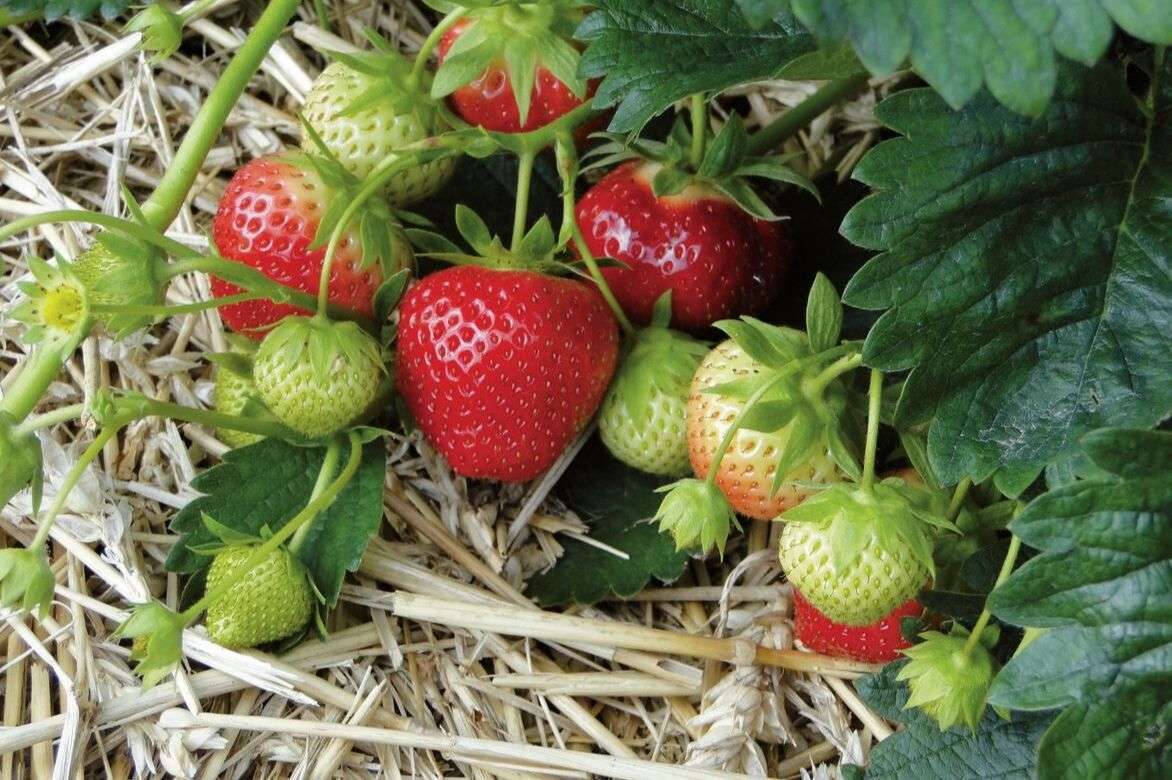
In pots : place a layer of gravel or clay pebbles at bottom of pot to improve drainage. Fill pot with a mix of potting compost, garden soil and compost.
→ See also our advice sheets : growing strawberries on a balcony ; How to plant strawberries in a trough? and our tutorial How to make a strawberry tower?
Care, diseases
Strawberry care is simple :
- Keep soil moist with regular watering during flowering and fruiting, especially in hot weather.
- Plant is sensitive to frost as soon as it has started to flower. To ensure abundant harvests, install a tunnel or winter fleece during cool nights.
- Install a filament of protection against birds before fruits ripen.
- In autumn, remove dry or spotted leaves.
- Apply compost to soil surface in spring.
- Remove overly abundant stolons or separate them from mother plant to replant elsewhere.
- Plants should be renewed every 3 or 4 years.
Wait 4 years before replanting strawberry plants in same location.
Les limaces et escargots peuvent s’attaquer aux jeunes plants ainsi qu’aux fraises. Installez de la cendre ou du marc de café ou autres pièges à bière pour les éloigner.
La maladie des taches pourpres qui affecte souvent le feuillage à l’automne nécessite rarement un traitement. Ôtez les feuilles tachées ou flétries avant la reprise de la végétation. Le botrytis est une pourriture grise qui affecte les fraises si la culture manque d’aération ou sont plantés trop serrés.
Le mildiou du fraisier et l’anthracnose sont deux maladies graves engendrées par des champignons du sol qui se déclarent sur soil humide ou quand le feuillage est mal aéré. Arrachez les plants et évitez de replanter des fraisiers avant un certain nombre d’années (voir fiches dédiées)
→ For more information, see these pages : Which mulch to choose for strawberry plants?, How to grow strawberries and Strawberry diseases and pests and How to fertilise strawberry plants naturally?
Propagation
Separating stolons in autumn is a very easy way to propagate large-fruited strawberry plants provided it is not affected by diseases (yellowing or leaf curl). Clump division or sowing is carried out on wild strawberry and its cultivars.
Clump division or stolon separation
- As soon as roots appear at base of young rosette of stolon, separate it from mother plant by cutting the stolon (horizontal aerial stem) with a clean, sharp blade.
- Replant rosettes immediately to expand crop or to give to a neighbour.
This operation also helps prevent mother plant from becoming exhausted.
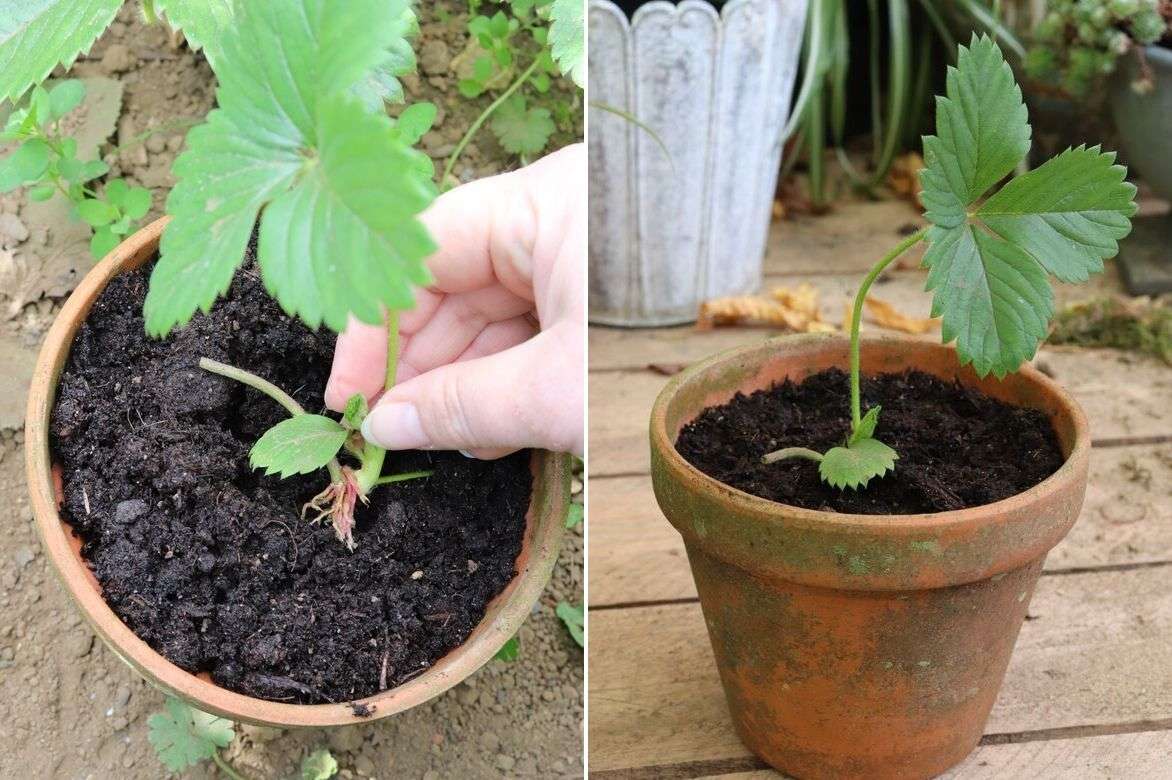
Stolon separation and transplanting of a new young strawberry plant
Sowing strawberry plants
These woodland strawberries are offered as seeds because they do not form stolons and retain their characteristics.
When to sow strawberry seeds?
Sowing can start from February through to June provided temperature is above 16°C (optimum 22°C), or in autumn. Growing under a cold frame, in a greenhouse or in a conservatory is therefore essential if starting early. Germination occurs in shade. Depending on sowing date, you may or may not need to keep pricked-out plants under an unheated cold frame.
How to sow?
- Place seeds for a few days in freezer compartment of your fridge then in the vegetable drawer. This process places seeds in natural conditions in which winter cold followed by spring warming stimulates germination.
- Prepare your substrate preferably the day before, with one third ‘seed’ potting compost mixed with one third fine garden soil and one third sand. Moisten mix by misting with water if necessary.
- The next day, fill a tray or an alveolate tray to brim without compacting.
- Sow seeds as thinly as possible, using tweezers if needed.
- Optionally cover with a fine layer of potting compost or vermiculite 1–2 mm thick then press lightly.
- Water with a fine spray and keep substrate moist.
Strawberry plants sometimes take a long time to emerge, up to 35 days, but only 15 days in June.
- When plants have 2–3 leaves, prick out individually into buckets 7–8 cm across, in a substrate of garden soil and potting compost or compost.
Planting out
Once frosts are no longer a risk, usually after the Ice Saints in mid-May, and plants have several leaves:
- Loosen soil to 20 cm depth and enrich with well-rotted compost.
- Rake level then dig holes spaced 35 cm apart,
- Set clumps in without burying the collar, pressing firmly to secure the plant.
A sowing in February allows harvesting strawberries from mid-June to November, whereas an autumn sowing allows harvesting from May.
Harvest and storage
Harvesting strawberries
Pick fruit from young plants as they reach ripeness. Strawberries are delicate; pick them with their peduncle by pinching the stem 1 to 2 cm above it. Fruit texture is a good indicator of ripeness. It should be firm yet give slightly to the touch.
Yields vary from 400 to 700 g/m² for the season for small-fruited strawberries, and average 1.5 kg/m² for large-fruited species, both perpetual and non-perpetual.
→ Read also: How to protect strawberry harvests?
Storage
Strawberries keep for about a week in your fridge’s vegetable drawer, but it is best to consume them quickly as the skin is very sensitive to knocks and pressure…
- Eat raw after a quick rinse under the tap, possibly with a little sugar, whipped cream or as a tart garnish. (Remove peduncles after washing).
- If your harvest is abundant, sugar is an excellent way to transform and preserve fruit as jams, marmalades, compotes or syrups. It is, of course, possible to make ice cream, sorbets or coulis, but these will keep for a shorter time.
- You can also dry them in the oven after slicing into thin strips of at least 1 mm to add to your muesli.
- Finally, strawberries freeze very well. Small freezing trays are now available for small fruits such as strawberries, raspberries or redcurrants, etc.
→ Discover our homemade strawberry jam recipe in our step-by-step tutorial!
Uses and companion plants
Young strawberry plants can form borders around a vegetable patch to save space. They can also be grown with garlic, onions and leeks, or with beans, lettuce, spinach or thyme. However, they do not get on well with cabbages and other brassicas.
With their production of stolons, they also make attractive hanging baskets, can adorn sunny green walls, be grown in wooden planters or a pyramid of stacked frames, allowing harvest while standing.
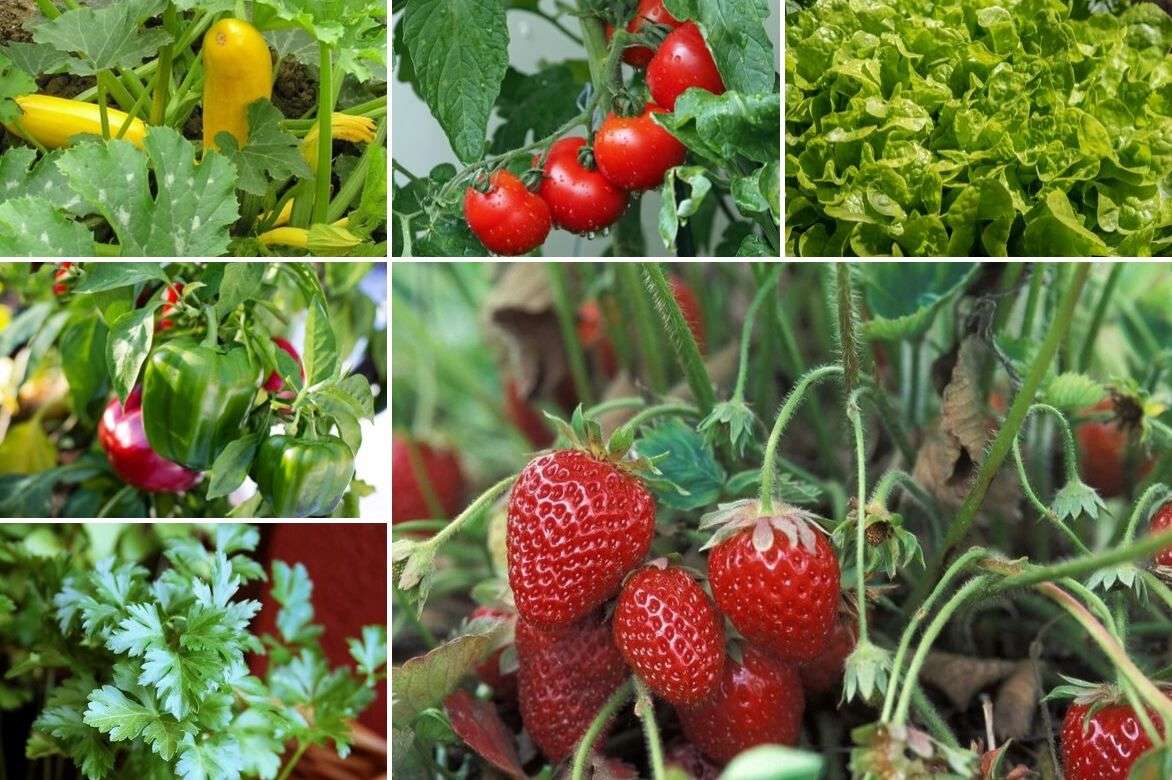
An idea for arranging pots on a terrace: grow strawberry plants near courgettes (non-running), tomatoes, peppers and chillies, salad leaves and herbs (thyme, rosemary, parsley, basil, chives, oregano…). You can also add flowers: marigolds, carnations, borage, lavender, summer heather, sage…)
Further reading
Discover:
- Our range of strawberry plants: many varieties, to harvest in spring and throughout summer
- Article : Strawberry plants: 3 reasons to plant in autumn
- Article : Wild strawberry: an endangered treasure
- Advice sheet : Planting bare-root strawberries
- Article : Strawberries in vegetable patch: stop the pilfering!
- Advice sheet : Choosing strawberry plants
- Our tutorials : How to make dried strawberries? ; Make syrup from strawberry stalks ; How to make strawberry Koso? Our easy recipe; How to obtain or propagate strawberry plants for free?
- Advice sheet : 5 small red fruits for beginners
- Advice sheet : Small fruits: tips to get beautiful fruit
- Advice sheet : Growing strawberries on balcony
- Advice sheet : Why my strawberry plants produce little (or no) fruit?
- Advice sheet : Best space-saving ideas for growing strawberries
- Pascale shares tried-and-true perpetual strawberries !
- Subscribe!
- Contents
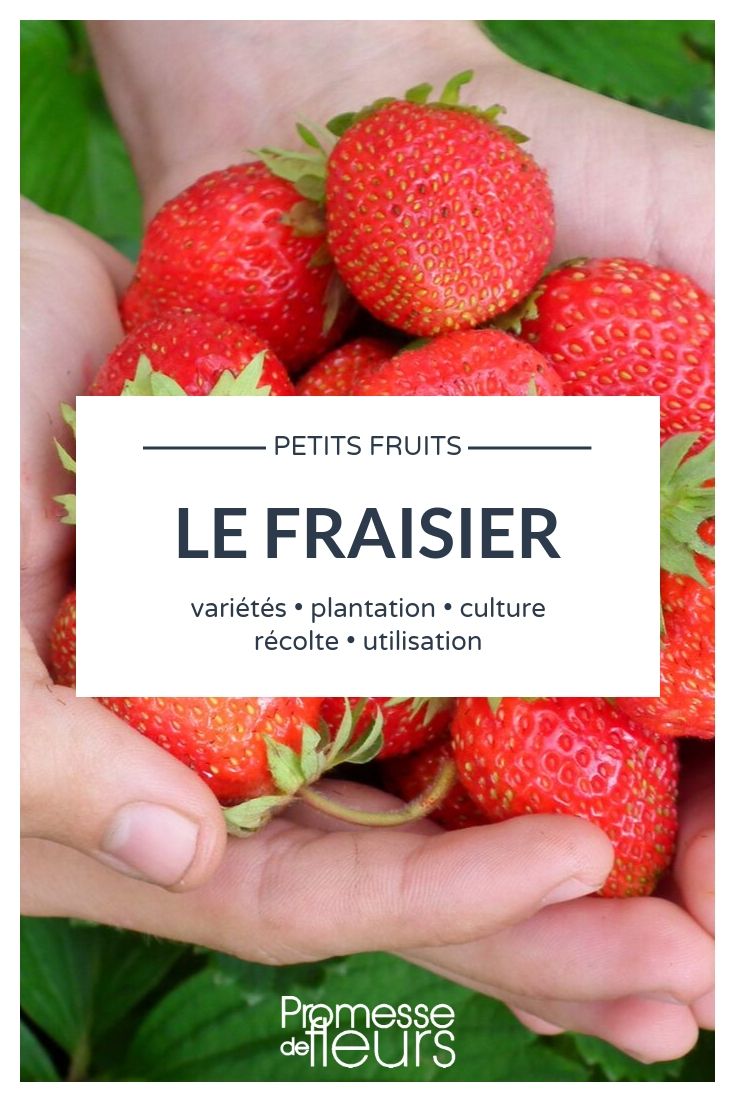































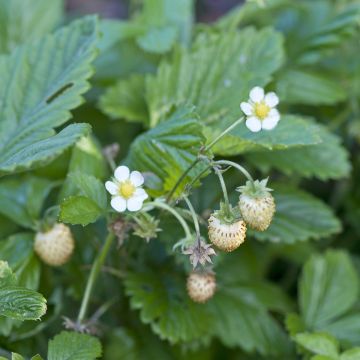
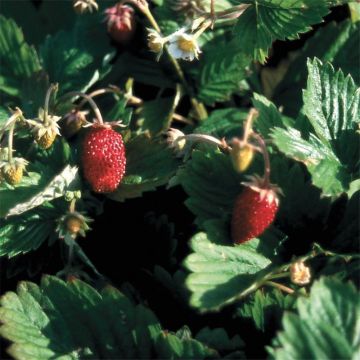

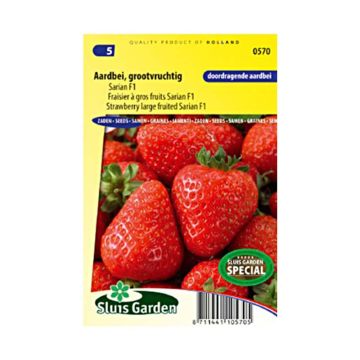
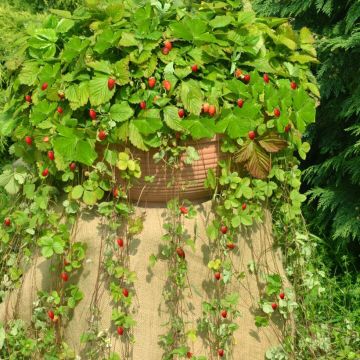
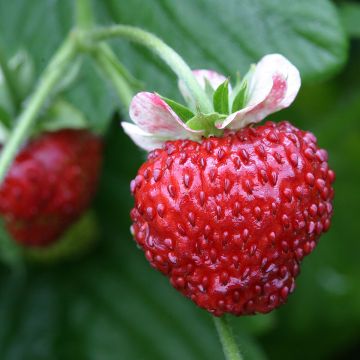
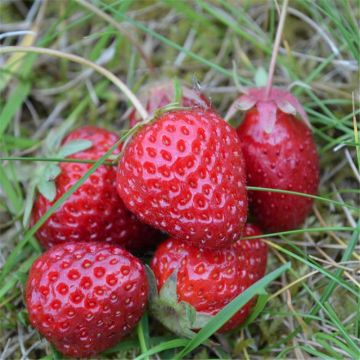
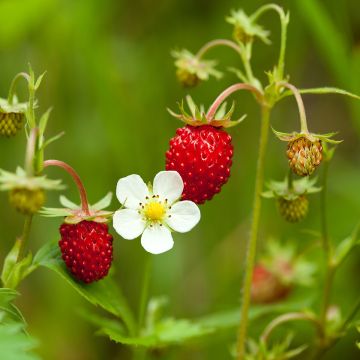
Comments